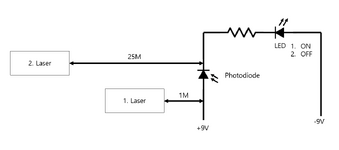sjbaek
Newbie level 4
1. When only photos, light-emitting diodes, and resistors are used and only 9V power is applied, the distance is close to the strong infrared signal (remote control signal), but it does not work even if it falls off.
2. In order to solve the problem of No. 1, I want to output a constant current (voltage) even if I receive a little signal from the photodiode.
2. In order to solve the problem of No. 1, I want to output a constant current (voltage) even if I receive a little signal from the photodiode.
